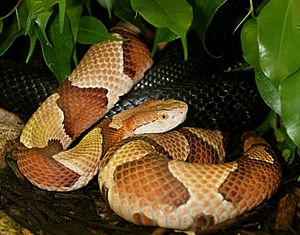Agkistrodon contortrix phaeogaster facts for kids
Quick facts for kids Agkistrodon contortrix phaeogaster |
|
|---|---|
 |
|
| Scientific classification |
|
| Kingdom: | Animalia |
| Phylum: | Chordata |
| Class: | Reptilia |
| Order: | Squamata |
| Suborder: | Serpentes |
| Family: | Viperidae |
| Genus: | Agkistrodon |
| Species: | |
| Subspecies: |
A. c. phaeogaster
|
| Trinomial name | |
| Agkistrodon contortrix phaeogaster Gloyd, 1969
|
|
Common names: Osage copperhead, central copperhead.
The Agkistrodon contortrix phaeogaster is a type of venomous snake known as a pit viper. It is a subspecies found in the central part of the United States.
Contents
Description
This snake can grow to different lengths. Males can be up to about 99 centimeters (39 inches) long. Females are usually a bit shorter, around 72 centimeters (28 inches). Some reports say they can even reach up to 101 centimeters (40 inches) long.
The Osage copperhead has a color pattern similar to another copperhead subspecies, Agkistrodon contortrix mokasen. However, the dark bands on the Osage copperhead stand out more against its lighter body color. It also does not have smaller dark spots between these main bands.
Geographic Range
You can find the Osage copperhead in the United States. It lives in eastern Kansas, the very southeastern part of Nebraska, and a large area of Missouri. The first place this snake was officially found and described was about 10 miles south of McLouth, in Jefferson County, Kansas.
Venom
The Osage copperhead is a venomous snake. Its venom is similar to the venom of other snakes in the Agkistrodon family. Snake venom is a complex mix of different substances. These substances can affect the body in various ways.
Safety Around Copperheads
If someone is bitten by an Osage copperhead, it is a serious situation. The person should get medical help right away. It's best to call an ambulance, especially if the person is alone. Driving after a snakebite can be very dangerous.
The venom can cause pain and swelling where the bite happened. It might also cause other problems in the body. These effects happen because the venom contains special toxins. Some toxins affect blood, and others can damage tissues.
Treatment for Bites
Doctors often use a medicine called CroFab antivenin to treat Osage copperhead bites. Antivenin is a special medicine that helps to fight the effects of snake venom. Doctors need to give the right amount of antivenin. They watch the patient carefully to make sure the medicine works well.
Sometimes, doctors also give other medicines. These can include pain relievers to help with discomfort. Muscle relaxers might be given to ease muscle stiffness. Antibiotics are also important. They help prevent infections from the bite wounds. It's very important to take all the antibiotics as prescribed. This helps make sure all bacteria are gone and prevents them from becoming harder to treat.
Antivenin Availability
CroFab antivenin is helpful for treating bites from the Osage copperhead. However, some people might have a strong allergic reaction to it. Doctors must be careful when using it, especially if someone has allergies. They weigh the risk of the allergy against the danger of the snakebite itself. Sometimes, there have been limited supplies of CroFab antivenin in the U.S. Doctors always make the best decisions for patients based on how severe the bite is and what treatments are available.
See Also

